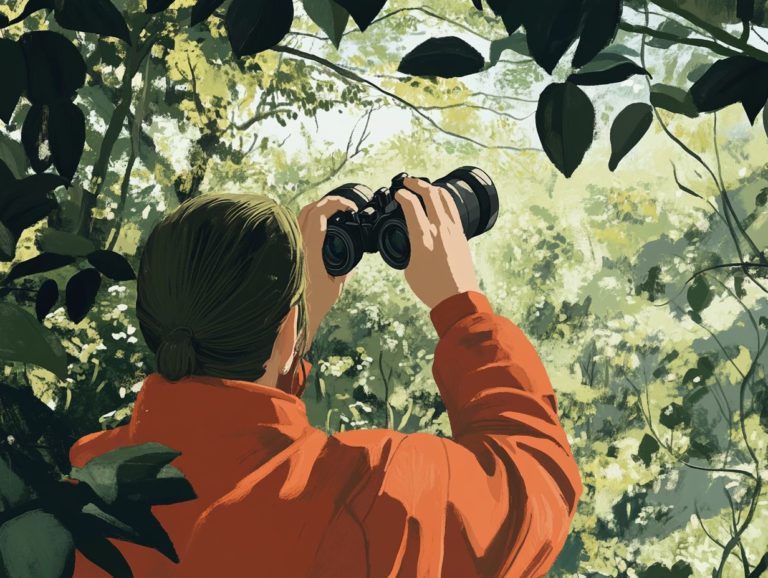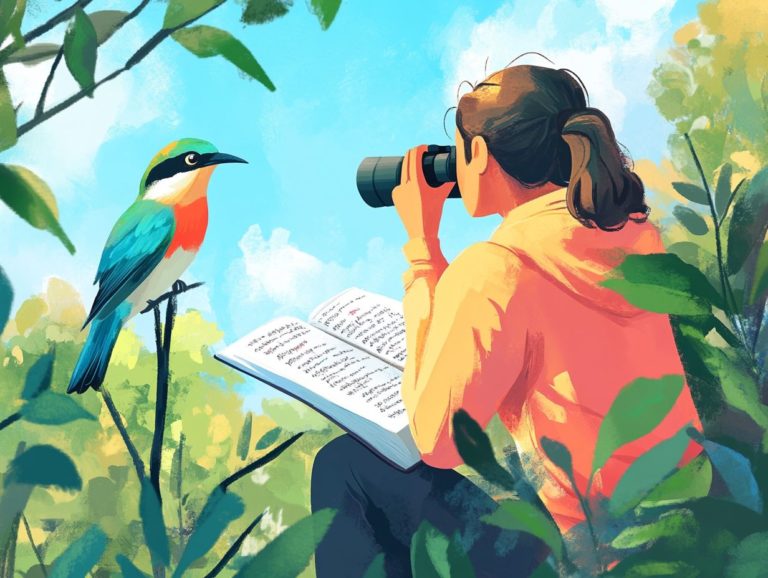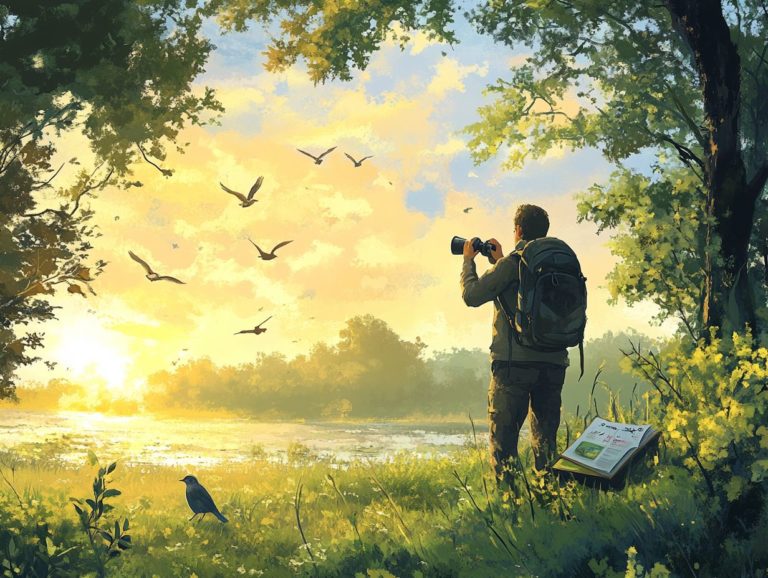10 Tips for Bird Watching from Your Backyard
Bird watching from your backyard offers numerous benefits, such as a deeper connection with nature and an enhancement of everyday life. It also promotes a rewarding hobby suitable for all levels of experience.
Contents
- Key Takeaways:
- 1. Choose the Right Location
- 2. Provide Food and Water Sources
- 3. Create a Bird-Friendly Environment
- 4. Use Binoculars or a Telescope
- 5. Learn to Identify Common Bird Species
- 6. Keep a Bird Watching Journal
- 7. Be Patient and Observant
- 8. Take Advantage of Different Weather Conditions
- 9. Join Online Birdwatching Communities
- 10. Participate in Citizen Science Projects
- What Are the Benefits of Birdwatching from Your Backyard?
- Frequently Asked Questions
- What are some tips for successful bird watching from my backyard?
- Can I attract specific types of birds to my backyard?
- How can I make my backyard bird watching experience more comfortable?
- What should I do if I spot an injured bird in my backyard?
- Is it safe to interact with the birds in my backyard?
- Can my backyard bird watching activities contribute to conservation efforts?
Key Takeaways:
- Choose the right location for optimal bird watching opportunities.
- Provide food and water sources to attract a diverse range of bird species to your backyard.
- Create a bird-friendly environment by incorporating trees, shrubs, and birdhouses.
1. Choose the Right Location
Choosing the right location for birdwatching is critical for attracting local birds and enhancing your backyard experience. This is especially important in urban areas, where the spread of buildings and roads can diminish natural habitats.
Select sites with abundant natural features like trees, shrubs, and nearby water sources. These features provide essential resources for birds, such as food, nesting areas, and shelter from predators.
Conservation efforts are essential for maintaining valuable habitats. By preserving green spaces and developing community initiatives to protect local ecosystems, you can enjoy richer experiences and have a greater chance of encountering both common and rare species. This ultimately deepens your appreciation for birds and wildlife.
2. Provide Food and Water Sources
Providing food and water sources in your backyard is key to attracting a variety of bird species, including local favorites like the Eastern Meadowlark and the Carolina Chickadee. Get ready to elevate your birdwatching experience to new heights!
Place various types of bird feeders to attract more birds, including:
- Tube feeders, preferred by most small songbirds.
- Platform feeders, which accommodate larger birds and allow multiple birds to feed simultaneously.
- Suet feeders, specializing in energy-rich offerings.
High-quality options, such as Black Oil Sunflower Seed, can attract dozens of bird species, from finches to cardinals. Clean water features, including bird baths and small ponds, are also crucial. Fresh water is essential for natural behaviors and breeding, so ensure to clean these sources regularly to prevent algae and bacteria buildup.
3. Create a Bird-Friendly Environment
Bird-friendly landscaping involves strategic planting and construction of features that support local wildlife habitats, particularly for specific bird species.
Friendly Bird Landscaping Features:
- Virginia Creeper Vine: This vine creates dense cover and shelter, providing a safe haven for many bird species.
- Red Maple: This tree offers nesting locations and attracts insects that serve as food sources for various birds.
Bird-Friendly Architectural and Developmental Choices:
- Layering different plant heights creates shelter for both ground-feeding and arboreal birds.
- Utilizing rocks and other natural terrain features establishes feeding and drinking spots for birds.
- Install bird feeders, baths, and nesting houses to supplement diminishing food and shelter resources.
Bird-Friendly Sustainable Landscaping Choices:
- Incorporate native plants that require less water and fertilizer while providing food sources for local wildlife.
- Employ techniques to enhance soil structure and promote healthy ecosystems to attract birds.
- Minimize pesticide use to ensure that local insects, essential food sources, remain available.
Bird-Friendly Construction Choices:
- Use biodegradable or natural building materials, such as wood, clay, and straw, to help protect wildlife habitats.
Start creating your bird-friendly backyard today and witness the beauty of nature unfold before you!
4. Use Binoculars or a Telescope
Binoculars and telescopes are essential tools for bird watchers who aim for high levels of observation and photography. They enable enthusiasts to observe minute details of birds in their natural habitats.
While both serve to enhance the viewing experience, binoculars typically offer greater portability and ease of use. This makes them more suitable for quickly spotting birds during hikes or casual excursions.
With few exceptions—such as for bird watchers interested in observing distant species or those needing a particularly powerful view—telescopes are not widely utilized within the bird watching community. For those who frequently change locations or embark on spontaneous birding trips, binoculars are the preferred choice.
When selecting the right optics, several important factors must be considered, including the strength of magnification, the field of view, and comfort level when looking through binoculars.
Mastering techniques such as quickly adjusting the focus and employing proper stabilization methods can significantly improve your ability to identify birds.
5. Learn to Identify Common Bird Species
Identifying common bird species, such as the Northern Cardinal and the Carolina Wren, is one of the most enjoyable aspects of bird watching. This practice helps you connect with nature and sharpens your observational skills.
Field guides that outline key identifying characteristics, including plumage, song, and habitat, serve as excellent resources for recognizing various bird species. Tools like the Sibley Backyard Birding Flashcards are particularly useful for memorizing and identifying different birds.
The experience of identifying these species can be further enriched by engaging in experiential practices such as journaling. Track your sightings, behaviors, and personal insights to promote awareness and enhance your learning experience.
By combining visual aids with experiential practice, you can foster a greater understanding of avian life while nurturing a love for the outdoors.
6. Keep a Bird Watching Journal
Start a Bird Watching Journal to supercharge your birding adventures! This practice enhances your birding experience and improves your mental health by promoting mindfulness and fostering deeper connections with the natural world.
Document your observations of various species, including their behaviors and distinctive markings. By noting the sounds of the birds you encounter during outings, you can gain a greater appreciation for the auditory environment around you.
Record personal stories about favorite sightings or leisurely mornings spent in nature. Such reflections can lead to a deeper understanding of avian life and may serve as a therapeutic outlet, bringing peace and tranquility to a busy life.
7. Be Patient and Observant
Patience and keen observation are essential skills for bird watchers, particularly during the early morning hours when many species are active. This provides prime opportunities for sightings.
Use mindfulness and move slowly for better bird watching. Remaining quiet and still not only aids in spotting elusive species but also strengthens your connection with nature.
Observing wildlife behaviors throughout the day enriches your bird watching experience. Some birds may be more vocal at dawn, while others forage for food around dusk. Understanding these habits can significantly increase your chances of encountering various species.
8. Take Advantage of Different Weather Conditions
Leveraging different weather conditions can significantly enhance your birdwatching experience. Various species tend to be more active during specific seasons, particularly in spring and fall, especially in areas impacted by urban sprawl.
For example, rainy days often entice certain birds that might otherwise seek shelter. Windy conditions can alter feeding patterns, making some species more visible as they look for refuge. Temperature variations also play a crucial role; warmer days may prompt migratory birds to search for food, leading to increased sightings.
To maximize your experience regardless of the weather, it’s wise to dress appropriately and use waterproof gear. Have a plan for managing windy or chilly conditions. Bringing binoculars that perform well in low visibility can greatly enhance your experience, allowing for close observation despite the elements.
9. Join Online Birdwatching Communities
Joining online birdwatching communities and birding clubs, such as the National Audubon Society, can greatly enhance your experience. Connecting with like-minded individuals provides valuable resources and support.
These forums allow members to share their own experiences and sightings. Participants can also find these communities on social media platforms like Facebook and Reddit, where they can engage in discussions about local species and migration patterns.
Many networks organize joint birdwatching trips and contests! Both advanced and beginner birdwatchers can expand their knowledge and passion for birds by actively participating in these communities.
10. Participate in Citizen Science Projects
Citizen science projects centered on birdwatching are among the most effective ways to support conservation efforts. They also provide an excellent opportunity to learn about local bird species and their ecosystems.
These initiatives enable individuals to collect vital information that assists scientists and researchers in assessing the status of bird populations and their seasonal movements.
The National Audubon Society offers various opportunities for birdwatchers to get involved, including the Annual Christmas Bird Count, where observers gather and report data on the presence of bird species across different regions. eBird serves as a platform for birdwatchers to report their observations in real-time, compiling a comprehensive database for scientists to analyze trends in bird populations.
What Are the Benefits of Birdwatching from Your Backyard?
Birdwatching from home offers several advantages:
- Improved mental health
- Reduced stress
- Sense of community among birdwatchers
- Conservation of the local ecosystem
Engaging in birdwatching encourages mindfulness. Individuals can be fully present as they observe and appreciate the beauty of birds. The slow pace of watching birds move from tree to tree calms the mind, alleviating anxiety and creating a natural refuge at home.
Birdwatching fosters relationships as individuals share their experiences, tips, and discoveries within the community. This sense of camaraderie enhances conservation efforts, encouraging collaboration in preserving habitats and promoting environmental stewardship.
So grab your binoculars and step outside today!
What Are the Essential Tools for Bird Watching?
Essential tools for birdwatching include binoculars, field guides, and mobile apps. These help enthusiasts identify and track various bird species.
Binoculars are important tools for observing not just birds, but all wildlife. Birdwatchers can choose from compact, waterproof, or high-magnification options.
Features like image stabilization, which helps reduce shaking for clearer views, and wide fields of view enhance the experience, making it easier to spot rare birds.
Along with binoculars, field guides play a significant role in birdwatching. These books provide valuable information about the bird species found in a specific area, often featuring illustrations and photos.
Field guides include details on their habitats, calls, and behaviors. They are available in both print and mobile formats.
Technology has further simplified bird identification through apps like Merlin. These birdwatching apps utilize advanced algorithms and crowdsourced data to assist users in identifying the birds they encounter.
By allowing users to narrow down species based on characteristics like color and size, these apps make each birding outing more informative and enjoyable.
How Can You Attract Specific Bird Species to Your Backyard?
Want to bring beautiful birds to your backyard? Thoughtful landscaping and the right food sources can work wonders!
Native plants are perfect; they attract insects, which many birds love to eat. Offering a mix of seeds, suet, and nectar can entice colorful visitors like hummingbirds and cheerful finches!
For instance, a hanging feeder filled with thistle seeds will attract goldfinches, while a tube feeder filled with nectar may bring in both orioles and hummingbirds.
What Are the Best Times of Day for Bird Watching?
The best times for birdwatching are typically early in the morning and late in the afternoon, as many species are most active during these periods, making them easier to observe.
Birds often feed and socialize with one another during these times. Comfortable temperatures encourage birds to come out in search of food or potential mates.
In contrast, midday, when the sun is at its highest point, often sees a significant decrease in bird activity; many birds seek shade or remain quiet to conserve energy.
To maximize the chances of spotting various species, birdwatchers should plan their outings around these optimal times. Utilizing local birding reports or apps that indicate recent sightings can also help determine the best locations to visit.
Being patient and positioned quietly will greatly enhance the likelihood of observing a diverse range of birds.
How Can You Involve Children in Bird Watching?
Birdwatching can be a wonderful family activity that fosters a love for nature. It educates children about local wildlife and conservation efforts.
This hobby encourages children to be attentive to their surroundings and can include exciting activities like scavenger hunts, where they search for specific types or colors of birds.
Building bird feeders can also be a fun family project, allowing children to attract various bird species to their backyard.
Engaging in these hands-on activities makes learning about different birds and their habitats enjoyable while also teaching responsibility and empathy for living creatures.
As they watch and document their observations, children develop critical thinking skills and gain a deeper understanding of biodiversity.
What Are Some Common Mistakes to Avoid While Bird Watching?
Common mistakes in bird watching stem from impatience, poor observational skills, or inadequate equipment. These factors can detract from the overall experience. For instance, making unnecessary noise can scare away birds, leading to frustration for bird watchers. Stay quiet to fully enjoy the wonders of bird watching!
Good binoculars and field guides are vital tools in a bird watcher’s kit. Having the right tools can facilitate the quick identification of various species. Patience is also crucial, as bird watching often requires long periods of waiting to catch a glimpse of a bird. Maintaining sharp observational skills not only aids in identifying different species but also fosters a deeper connection with nature, enhancing the enjoyment of the hobby.
Frequently Asked Questions
What are some tips for successful bird watching from my backyard?
- Set up a bird feeder or birdbath to attract birds.
- Choose a quiet, comfortable spot to observe.
- Use binoculars or a spotting scope for a better view.
- Keep a bird identification guide handy.
- Observe during early morning or late evening when birds are most active.
- Be patient and still to avoid scaring away birds.
- Use a camera or smartphone to capture photos.
- Create a suitable habitat by planting native plants and trees.
- Keep your backyard clean and free from hazards.
- Respect the birds and their natural behaviors while observing.
Can I attract specific types of birds to my backyard?
Yes, you can attract certain types of birds by offering the right type of food or nesting materials. Research the types of birds you want to attract and provide the appropriate resources to entice them to your backyard.
How can I make my backyard bird watching experience more comfortable?
- Invest in a comfortable outdoor chair or set up a blanket to sit on.
- Bring snacks and drinks to enjoy while you observe.
- Wear appropriate clothing and sunscreen to protect yourself.
- Use bug repellent to keep insects at bay.
- Have a nearby table to place your birding equipment and supplies.
What should I do if I spot an injured bird in my backyard?
If you see an injured bird, contact your local wildlife rehabilitation center. Do not try to handle the bird yourself, as it may cause further harm. Keep a safe distance and wait for professional help to arrive.
Is it safe to interact with the birds in my backyard?
For further insight, consider seeking guidance from experts like Rich Merritt and Sharon Stiteler, who can provide valuable tips on bird watching and conservation. Joining online groups or local bird watching clubs can enhance your knowledge.
Resources such as The Backyard Birdwatchers Bible and Sibley Backyard Birding Flashcards can help you learn more about various species. Bird food options like Morning Song Birdwatchers Blend Wild Bird Food and Black Oil Sunflower Seed will attract a variety of birds including the Northern Cardinal and Tufted Titmouse. Planting Virginia Creeper Vine and Red Mulberry in your backyard can also provide excellent habitats.
While interacting with birds can be a fun experience, it is important to keep a safe distance and not try to touch or handle them. Birds can become aggressive if they feel threatened, and some species may carry diseases that can be harmful to humans. It is best to observe and appreciate them from a distance.
Can my backyard bird watching activities contribute to conservation efforts?
Yes! By attracting and observing birds in your backyard, including species like the Eastern Meadowlark and Carolina Chickadee, you contribute to local conservation efforts. You can help monitor bird populations through platforms like the Merlin app.
Create a bird-friendly backyard habitat, which can include plants like Red Maple and American Holly. Participate in local bird counts or surveys organized by groups such as the National Audubon Society and the National Wildlife Federation.
Get out there and start spotting birds today!




